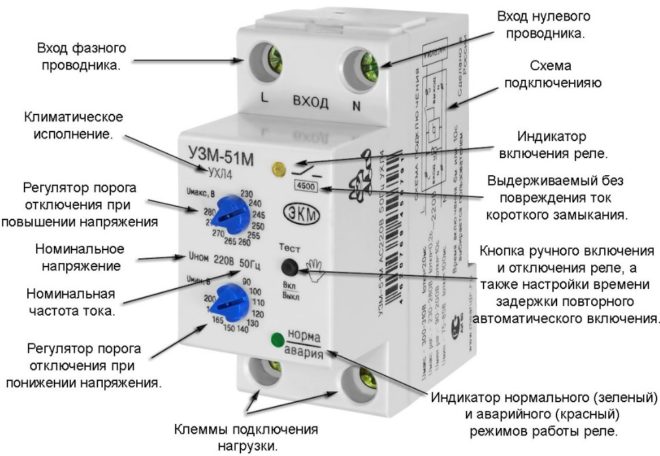220 volt surge protection device for home and apartment
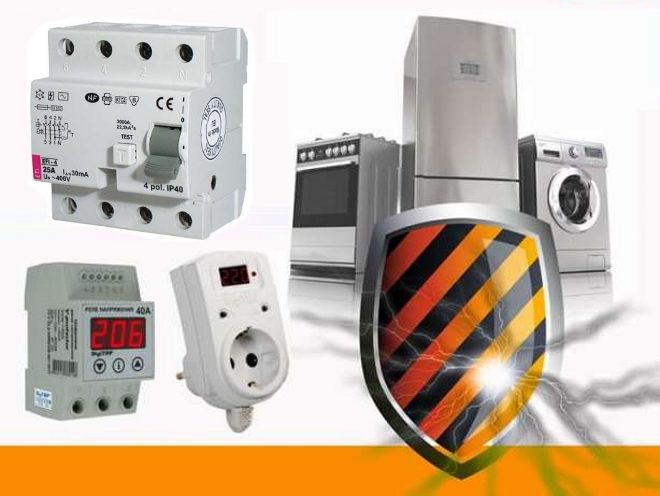
Electric energy is an integral part of the life of modern people, wherever they live - in the city or in the countryside. It is difficult to imagine an apartment or house where there is not a single household appliance, and candles or torches are used for lighting. However, all household appliances, as well as lighting elements, to which power is supplied through the home line, are at risk of voltage instability. Exceeding the permissible limits by this indicator entails serious problems, up to and including the breakdown of expensive equipment and line failure. Protection against voltage surges 220V for the home will help to save wiring and devices. In this material we will tell you how to protect your equipment from voltage surges in an apartment or in a private house with your hands.
Content
What are the causes of voltage drops in the network?
The power supply system in our country is far from perfect. Because of this, the prescribed voltage value of 220V, with the expectation of which all household appliances are manufactured, is not always maintained. Depending on what load at a particular moment falls on the network, the voltage in it can fluctuate significantly.
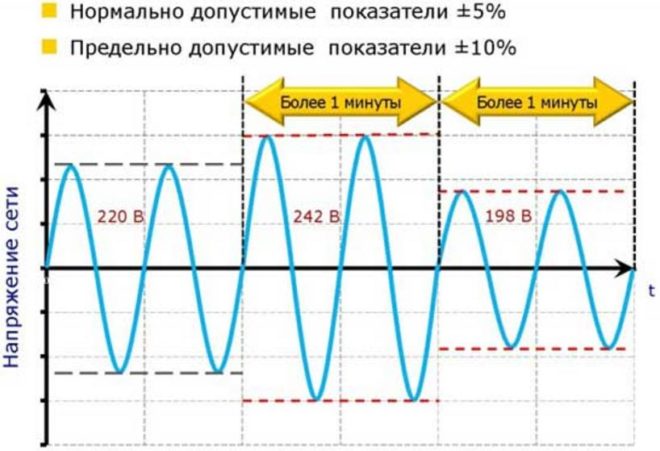
Power surges in our networks are not uncommon due to the fact that the overwhelming majority of all elements of the power supply system were developed several decades ago and were not designed for modern load. Indeed, in almost any modern apartment there are many home energy consumers. Of course, this makes living more comfortable, but at the same time significantly increases the consumption of electricity. The line cannot always cope with such loads, which results in frequent voltage drops.
One way to protect against network overvoltage on video:
It is not worth hoping that the old system will soon be completely redesigned to meet modern requirements. Therefore, protection against voltage surges of the power line and the devices connected to it is the task, in solving which the owners have to think with their own head and work with their own hands.
Now let's talk about the reasons due to which power surges occur in more detail. Usually, changes in the potential difference occur without sudden surges, and modern technology, designed to work in the range from 198 to 242V, is able to cope with them without damage to itself.

We will talk about those cases when the voltage rises several times within a fraction of a second, and then decreases just as quickly. This is what is called a power surge. Here are the reasons why it most often occurs:
- Simultaneous switching on (or, conversely, switching off) of several devices.
- Breakage of the neutral conductor.
- Lightning strike into a power line.
- The rupture of the cores inside the wire due to a tree falling on a power line
- Incorrect connection of cables in the general electrical panel.
As you can see, a power surge can occur for various reasons. It is simply unrealistic to predict when it will happen, which means that you should think about protection against voltage surges in advance.
An example of mounting a voltage relay on the video:
How to protect your equipment from overvoltage?
Of course, the best option for protecting against overvoltage in the home network and the devices included in it is a complete reconstruction of the power supply system with its subsequent maintenance by experienced specialists.But if it is still possible to completely replace the wiring in a private house, then in apartment buildings this is unrealistic. Practice shows that several dozen tenants will almost never be able to agree on joint payment for such work.

It is unlikely that management companies will do this either. And it is useless to change the wiring in a single apartment - power surges from this will not go anywhere, since they arise, as a rule, due to common equipment.
What to do to prevent power surges from causing serious damage? Can't wait until utilities and all housemates want to replace the common electrical wiring in the building? There is only one answer - to choose a reliable device to protect your home network from power surges.
Today, the following devices are used to increase the safety of home equipment and to minimize the likelihood of damage due to overvoltage:
- Voltage control relay (RKN).
- High voltage sensor (DPN).
- Stabilizer.
Uninterruptible power supplies should be mentioned separately. They are close to the listed devices, but they cannot be called full-fledged devices for protecting the line from potential differences. We will discuss them in more detail below.
Voltage monitoring relay
When power surges in an apartment occur infrequently and there is no need for constant protection against them, it is enough to connect a special relay to the network.

What is this element? The RKN is a small device, the task of which is to turn off the circuit in the event of a potential difference and to resume the supply of electricity after the network parameters return to normal. The relay itself does not in any way affect the magnitude and stability of the voltage, but only records the data. These devices are of two types:
- A common block that is installed in the switchboard and protects the entire apartment from overvoltage.
- A device that looks like an extension cord with sockets for electrical outlets, into which individual appliances are connected.
Clearly pen the principle of operation of the voltage relay on the video:
When purchasing a relay, it is important not to make a mistake in calculating its power. It should slightly exceed the total power of the devices connected to the device. Individual RKNs, which are included in the general network, are not difficult to select - you just need to buy an element with the required number of outlets.
These devices are convenient, have a low cost, but it makes sense to use them only when the network is stable. If power surges in it constantly occur, this option will not work - after all, few of the owners will like the continuous on-off of the entire network or individual devices.
Voltage drop sensor
This sensor, like the RKN, records information about the value of the potential difference, disconnecting the network in case of overvoltage. However, it functions according to a different principle. Such a device must be installed in the network together with a residual current device. When the machine detects a violation of the network parameters, it will cause a leakage current, detecting which, the automatic protection device (RCD) will de-energize the network.
Voltage regulator
In those lines that need constant protection against voltage surges, it is necessary to install a network stabilizer. These devices, being included in the line, regardless of the potential difference supplied to them, normalize the parameters at the output to the desired value. Therefore, if power surges in your home network occur frequently, a stabilizer will be the best solution for you.
These devices are classified according to the principle of operation. Let's figure out which one is suitable for different cases:
- Relay. Such devices have a fairly low price and low power. However, they are quite suitable for protecting household equipment.
- Servo-driven (electromechanical).In terms of their characteristics, such devices are not much different from relay ones, but at the same time they are more expensive.
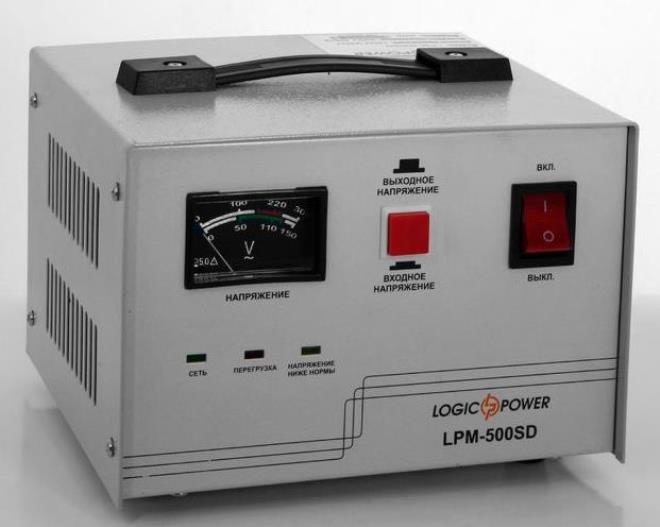
- Electronic. These stabilizers are assembled on the basis of thyristors or triacs. They have a sufficiently high power, are accurate, durable, have a good response time and almost always guarantee reliable protection against overvoltage. Their price, of course, is quite high.
- Electronic double conversion. These devices are the most expensive of all of the above, but at the same time they have the best technical parameters and allow you to provide maximum protection for the line and devices.
Stabilizers are single-phase, intended for connection to a home line, and three-phase, which are installed in the network of large objects. They can also be portable or stationary.
Visually about the stabilizers in the video:
Choosing such a device for yourself, you should first calculate the total power of the energy consumers that will be connected to it, and the limit values of the mains voltage. We recommend that you resort to the help of specialists in this matter - they will help you not to get confused in the technical intricacies and choose the best option for a particular line in terms of characteristics and cost.
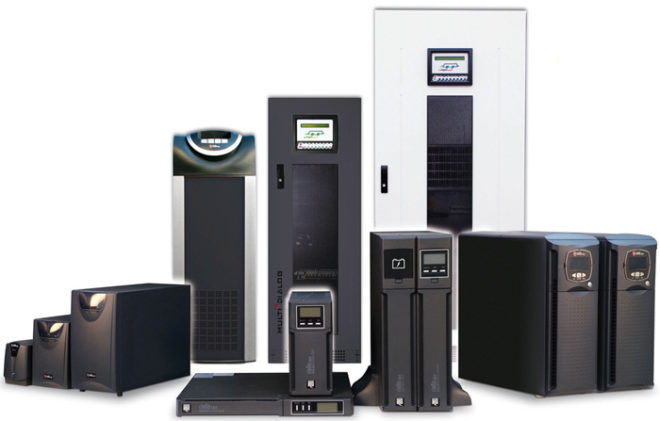
Uninterruptible Power Supplies
Now let's talk about these previously mentioned devices. Sometimes inexperienced users confuse them with voltage stabilizers, but this is not at all the case. The main task of the UPS is to provide the connected devices with power for a certain period of time in the event of a sudden power outage, which will allow them to smoothly shut down, preserving the available information. The power reserve is provided by the accumulators built into the device. As a rule, uninterruptible power supplies are used together with computers.
In some UPSs, for example, with an interactive circuit or double conversion mode, there are built-in stabilizers that are able to neutralize small differences in potential differences, but at the same time their price is very high, and they are poorly suited for general network protection. Therefore, they cannot be considered a full replacement for the stabilizer. But for protecting your PC in case of sudden power outages, such devices are truly irreplaceable.
Conclusion
In this article, we figured out what protection against power surges 220V for the home is for and with what devices it can be provided. As the readers could see, a powerful and expensive stabilizer will most reliably protect household appliances from overvoltage.

However, this does not mean that nothing else can solve the problem of potential differences. In many cases, other listed devices will do as well. It all depends on the parameters of the network and its stability.

